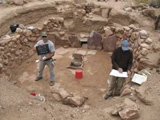|
|
TODAY.AZ / Weird / Interesting
Archaeologists use a hacked kinect to create 3-D scans of dig sites
04 August 2011 [11:31] - TODAY.AZ
 Archaeological digs are a painstaking process even after the earth has been excavated — artifacts must be carefully catalogued so researchers know exactly where they were found, which tells information about their past. On an upcoming dig in Jordan, a modified Kinect could serve as a 3-D scanner, making this process simpler — and decidedly more high-tech.
Archaeological digs are a painstaking process even after the earth has been excavated — artifacts must be carefully catalogued so researchers know exactly where they were found, which tells information about their past. On an upcoming dig in Jordan, a modified Kinect could serve as a 3-D scanner, making this process simpler — and decidedly more high-tech.Researchers hope students traveling to an archaeological dig in Jordan will use a hacked Microsoft Kinect as a mobile scanning system, making 3-D models of ancient sites that can then be visited in a virtual-reality environment.
For now, the system relies upon an overhead camera system, so it only works indoors, but computer scientists at the University of California-San Diego want to modify it so it will work in the field. Researchers at UCSD are planning a future trip to archaeological sites in Jordan, where the system could help catalog their finds.
Jürgen Schulze, a research scientist at UCSD’s division of the California Institute for Telecommunications and Information Technology (Calit2), eventually want to use the Kinect to scan entire buildings and neighborhoods. This ability would have applications far beyond archaeology, Fast Company points out.
The modified ArKinect — archaeology and Kinect — would scan an entire dig site, and the data would be used to reconstruct the site in 3-D. Calit2 has an immersive VR system called StarCAVE, a 360-degree, 16-panel setup, which allows researchers to interact with virtual objects. A realistic 3-D portrayal of ancient cookware, for instance, would be a lot more valuable than a 2-D photograph, because it would show more detail and craftsmanship and even help researchers understand how an artifact was used.
“There may be experts off site that have access to a CAVE system, and they could collaborate remotely with researchers in the field,” Schulze said in a UCSD release.
The technology could potentially help recovery efforts in disaster zones by digitizing a scene that can then be viewed remotely, he said.
/Popular Science/
URL: http://www.today.az/news/interesting/92011.html
 Print version
Print version
Views: 1849
Connect with us. Get latest news and updates.
See Also
- 05 February 2025 [19:41]
Japan plans to negotiate with Trump to increase LNG imports from United States - 23 January 2025 [23:20]
Dubai once again named cleanest city in the world - 06 December 2024 [22:20]
Are scented candles harmful to health? - 23 November 2024 [14:11]
Magnitude 4.5 earthquake hits Azerbaijan's Lachin - 20 November 2024 [23:30]
Launch vehicle with prototype of Starship made its sixth test flight - 27 October 2024 [09:00]
Fuel prices expected to rise in Sweden - 24 October 2024 [19:14]
Turkiye strikes terror targets in Iraq and Syria - 23 October 2024 [23:46]
Kazakhstan supplied almost entire volume of oil planned for 2024 to Germany in 9 months - 23 October 2024 [22:17]
Taiwan reported passage of Chinese Navy aircraft carrier near island - 23 October 2024 [21:50]
Russia remains largest oil supplier to India
Most Popular
 Ruins of an Azerbaijani mosque are being desecrated in Yerevan
Ruins of an Azerbaijani mosque are being desecrated in Yerevan
 Armenians are preparing for a "crusade" against Baku – hopes for the United States
Armenians are preparing for a "crusade" against Baku – hopes for the United States
 Azerbaijan bans entry of Russian MP over offensive remarks
Azerbaijan bans entry of Russian MP over offensive remarks
 February proves unsuitability of Pashinyan's project
February proves unsuitability of Pashinyan's project
 Trial of criminal case against Ruben Vardanyan continues
Trial of criminal case against Ruben Vardanyan continues
 Azerbaijan rejects Armenian PM's claims, calls out military buildup and territorial ambitions
Azerbaijan rejects Armenian PM's claims, calls out military buildup and territorial ambitions
 SSS arrests Azer Bagirov in Jordan and brings him to Azerbaijan
SSS arrests Azer Bagirov in Jordan and brings him to Azerbaijan
